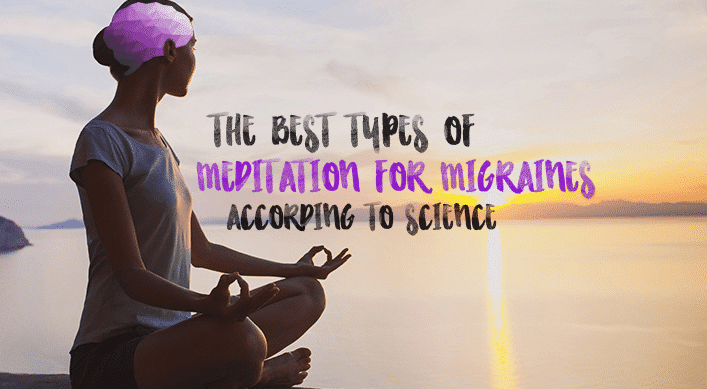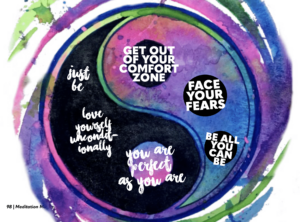While there is no cure for migraines, studies have shown that meditation for migraines may be an effective, pharmaceutical-free way to alleviate the painful throbbing as well as reduce the frequency and severity of future migraine attacks.
A migraine is to a headache as a firehose is to a sprinkler.
If you suffer migraines, you understand the amount of sheer pain, sometimes accompanied by nausea, auras, and other symptoms, that is experienced. You may have tried medications but found them to be ineffective or could not tolerate the side effects. Lying down in a dark room with a cold compress isn’t enough.
While there is no cure for migraines, it has come to light that meditation may be an effective, pharmaceutical-free way to alleviate the painful throbbing as well as reduce the frequency and severity of future migraine attacks.
The practice of either meditation or mindfulness-based stress reduction has been found in clinical studies to be more effective than drugs at lessening the misery of migraines and making a positive effect on overall health.
The Migraine – Definition, Research Findings, & Statistics
Migraines have been described as moderate to severe headaches experienced as throbbing head pain on one or both sides of the head. Migraines may be triggered by stress, tension, or anxiety. Stress causes the release of cortisol and norepinephrine — brain chemicals that accompany the “fight or flight” syndrome.
- 30% of adults all over the world suffer from migraines.
- Some migraineurs (migraine sufferers) experience nausea, photophobia, and/or phonophobia.
- One in five women suffers migraines in comparison to one in fifteen men.
- The frequency of migraines can be as little as a few times a year to as many as a few times a week.
The pain is typically so severe that it prevents you from performing your work or other daily activities. Nearly 1.8 hours per week of productive time is lost to migraines in the U.S. alone.
Brain imaging has shown migraineurs have decreased gray matter volume compared to non-sufferers, especially in the areas that control emotion, perception, decision-making, self-regulation, memory, and problem-solving. MRI studies have also shown that the neurotransmitters dopamine, melatonin, and serotonin are affected.
The Limitations of Pharmaceuticals
The available drugs for treating migraine pain only provide about 50% of people with a meaningful clinical response. Over 10% discontinue medications due to the impact of the side effects on their daily lives.
Ibuprofen and other painkillers may provide slight relief, but some sufferers won’t feel it. Another issue with drugs is the chance of medication overuse, resulting in migraines that are worse and harder to manage.
An Overview of Meditation and Mindfulness
Mindfulness has been described as “non-judgmental moment-to-moment awareness.” It is the ability to look inside yourself and examine the workings of your emotions in the moment with more dispassion. You focus on how you feel instead of what you think.
Meditation is often associated with Eastern spiritual practices, but anyone can learn it without the need to become a yogi or commit to a particular set of religious beliefs. There are several types of meditation, each with its own definition and practices.
- Zen meditation involves deep introspection and seeks the knowledge of the self.
- Vipassana is an ancient mind-body exercise practiced by Gautama Siddartha, the Buddha.
- Transcendental meditation comes from the Hindu faith and involves using sound and mantras.
- Yoga is a combination of physical exertion and meditation that is often recommended for migraine patients.
- Mindfulness is a Buddhist practice that goes beyond Vipassana to build total awareness.
Studies have been performed for mindfulness and meditation, finding that both are effective at reducing migraine pain and occurrence.
Interestingly, spiritual meditation appeared to provide the most benefit of all the therapies.

The Effectiveness of Mindfulness and Meditation
A treatment called MBSR (mindfulness-based stress reduction) was tested by Dr. Rebecca Wells and a group of researchers at Brigham and Women’s Hospital in Boston, MA. Dr. Wells and her colleagues carried out a small pilot program to “assess the safety, feasibility, and effects of a standardized, eight-week MBSR course in adults with migraines.”
The results of Dr. Wells’ study showed that the MBSR participants experienced a downward trend in the frequency and severity of their migraines. The study also found that the headaches were shorter in duration and had less impact on the sufferer’s activities.
Another group of researchers from the University of Massachusetts Medical School, consisting of Amy Wachholtz, Christopher Malone, and Kenneth Pargament, looked at whether spirituality and spiritually based meditation may be more effective than secular meditation and relaxation.
Groups of participants were formed. One group was given a spiritual phrase to use in meditation; another group was given an internally focused secular phrase; a third group used an externally focused secular phrase; and a fourth learned progressive muscle relaxation with no phrase.
What the study found was that, although there was no difference in severity of the migraines suffered during the study period, the frequency of migraines was noticeably affected, particularly for those in the spiritual meditation group.
In fact, the reduction in frequency among the spiritual meditation group was significantly lower when measured against the other groups and the participants’ history before the study was performed.
Also, the spiritual meditation group had a significantly lower analgesic use than the other groups when a migraine occurred, even when the perception of severity was the same, indicating a higher pain tolerance than the other groups.
Which Type of Meditation Is Best for Migraines?
Results from both studies show that the regular practice of meditation or mindfulness of any sort can help reduce the frequency and severity of migraines. The second study seems to show that if a spiritual component is introduced the frequency drops even further and less medication is needed to manage the pain.
While there is no consensus on why such techniques work, many think such stress-relieving practices increase the blood flow and amount of oxygen in the brain and throughout the body. Cortisol and norepinephrine levels decrease, serotonin is well regulated, and dopamine and melatonin levels increase, all of which counteract the adverse impact of migraines, especially in people with gray matter depletion.
Since stress is a known trigger for migraines, it makes sense that relaxation and stress reduction techniques help migraineurs reduce the amount of time they spend trying to manage the pain and increase the quality of life.
TL;DR: The best type of meditation for migraines seems to be techniques that include a spiritual component, rather than completely secular meditations techniques.
With meditation and mindfulness, there are no side-effects as there are with drugs and you spend time each day becoming more centered and less anxious. Try each technique to see what works best for you.
After all, it may help, and it definitely won’t hurt.
















